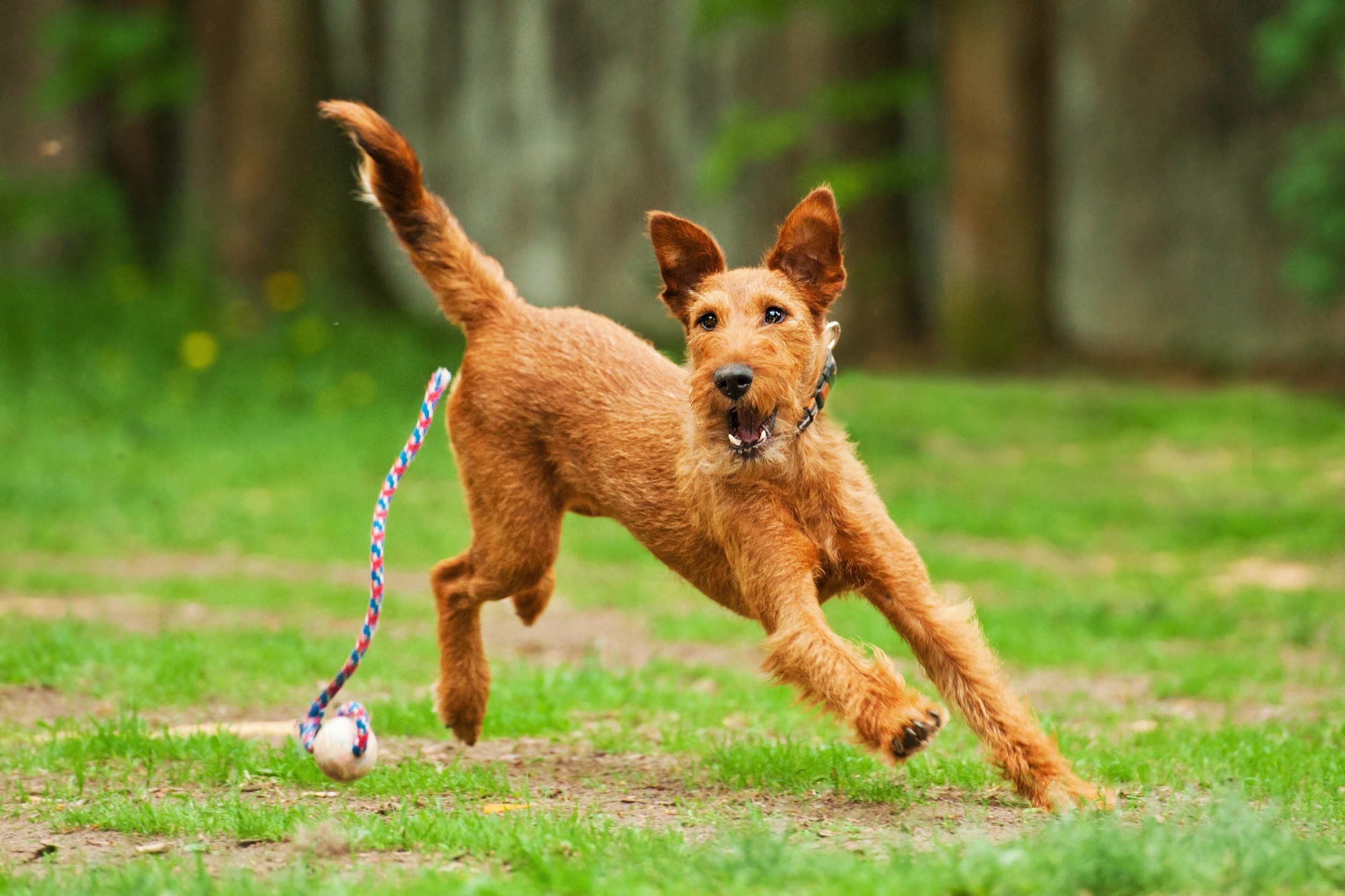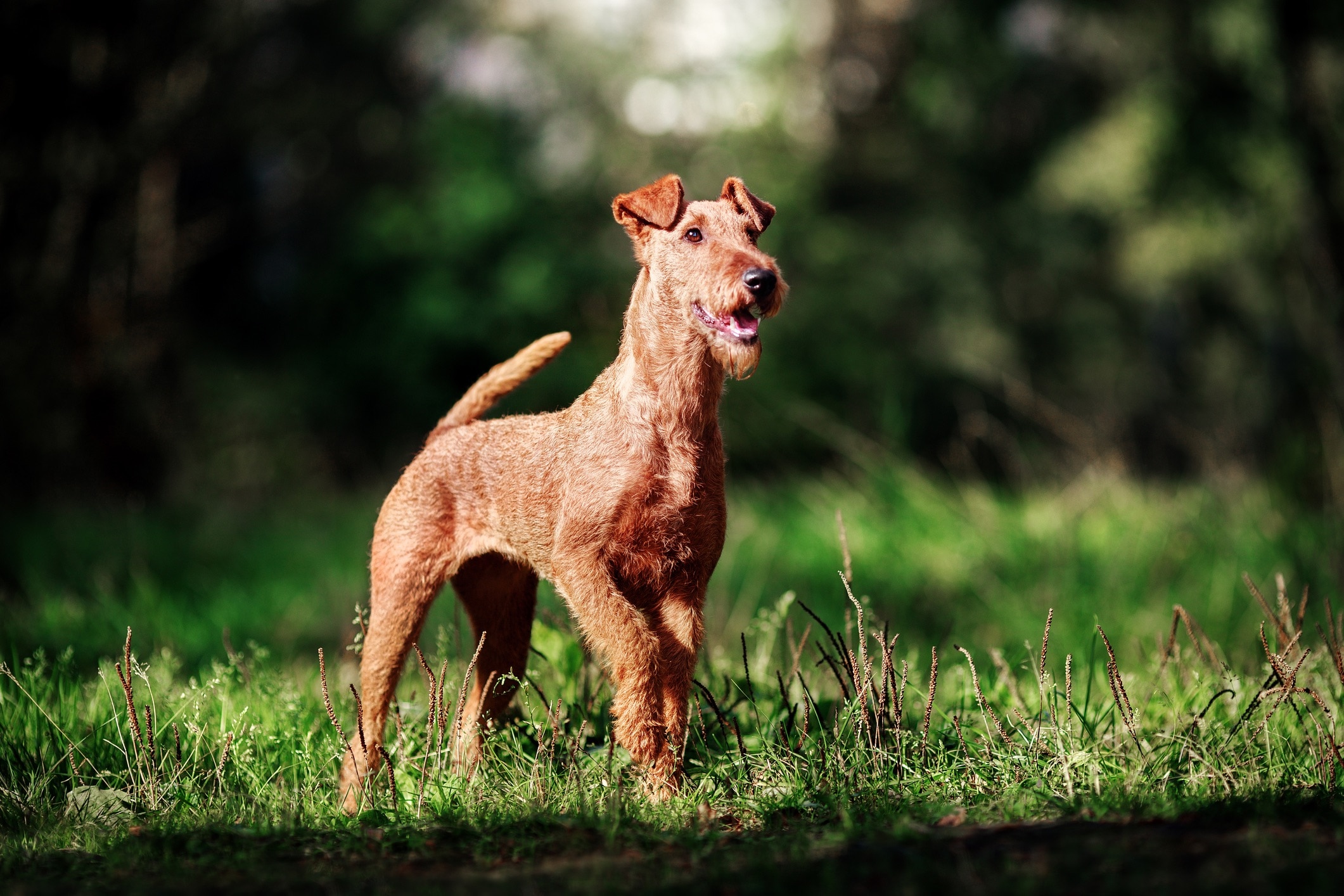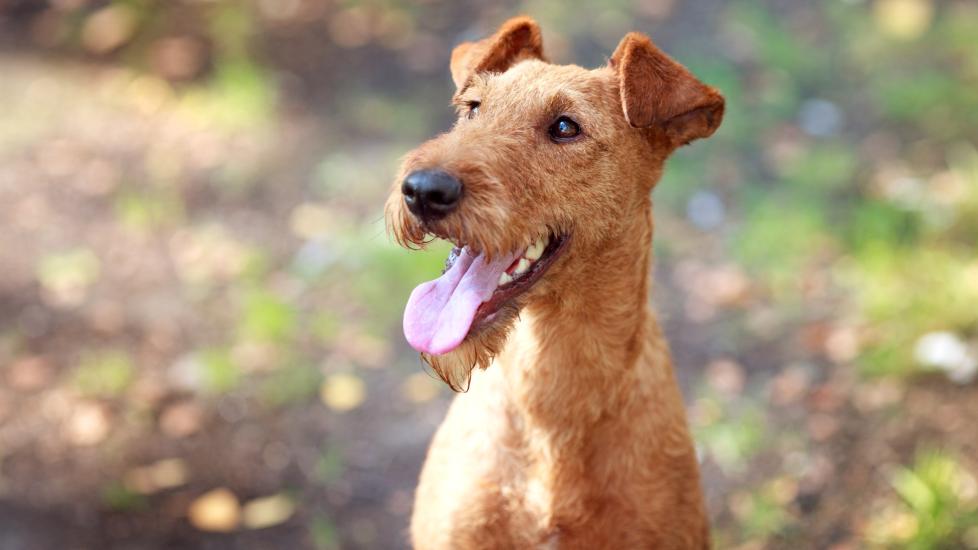Irish Terrier
The Irish Terrier, as the name suggests, is a terrier dog hailing from Ireland. They’re known for their fiery red coat and spirited demeanor, earning them the nickname “the red devil of the terrier group,” according to the Irish Terrier Club of America (ITCA).
The Irish Terrier’s temperament made them successful messenger dogs during World War I. At home, the breed is witty, affectionate, and loyal to the people they love.
Caring for an Irish Terrier
These dogs are known for their courageous, adaptable, and intelligent nature. Irish Terriers possess a high energy level, requiring regular exercise to maintain a healthy physique and stay mentally stimulated. Along with the need for daily exercise, the Irish Terrier has a stunning red, wiry coat that needs routine grooming to keep it in top condition.
The Irish Terrier size is about 18 inches tall and 25–27 pounds.
Irish Terrier Health Issues

Generally, Irish Terriers are healthy dogs with an average lifespan of 13–15 years, typical for a medium-sized dog. But like all dogs, they can be predisposed to certain health conditions. Purchasing pet insurance for your Irish Terrier puppy may be a good idea to stay on top of unexpected healthcare costs.
Hyperkeratosis
Hereditary footpad hyperkeratosis (HFH) is a genetic disease that causes thickening and cracking of the footpads. While this condition is uncommon in today’s Irish Terrier lines, they can be genetically predisposed. There is no specific treatment for the disease, but genetic testing can determine if a dog may carry the defect.
Cystinuria
Cystinuria is the presence of cystine crystals in the urine, caused by the kidneys failing to reabsorb the amino acid cystine. Cystinuria can lead to the formation of stones in the urinary tract. If left untreated, this can obstruct the flow of urine, which can be life-threatening.
Irish Terriers are predisposed to cystinuria and, while uncommon, the condition tends to affect males around 4–5 years old. When diagnosed, your vet will recommend a prescription diet that can help reduce cystine concentrations in the urine.
Hip Dysplasia
Hip dysplasia is common among many dog breeds, including the Irish Terrier. Hip dysplasia describes when the bones of the hip joints do not align appropriately. This causes rubbing and grinding of the bones that, over time, results in deterioration of the joint, loss of function, and arthritis.
Hip dysplasia can be a hereditary condition that affects Irish Terriers. But it can also be exacerbated by other contributing factors such as exercise habits, weight, and nutrition. Regular vet visits and weight management can mitigate potential problems.
What To Feed an Irish Terrier
The Irish Terrier requires a well-balanced diet rich in protein, fiber, and other essential nutrients. It’s best to look for a diet that meets Association of American Feed Control Officials (AAFCO) standards for the dog’s life stage (puppy, adult, or senior). Always talk with your veterinarian about what food to feed your dog.
How To Feed an Irish Terrier
Irish Terrier puppies need to eat three to four times every day. Full-grown Irish Terriers do well when fed two or three times daily to help maintain a steady energy level.
How Much Should You Feed an Irish Terrier?
AAFCO-compliant dog food packaging will include a feeding chart that recommends meal portions for your dog based on their ideal weight. However, how much you should feed your dog depends on your pup’s age, size, activity level, and health. Speaking with your veterinarian is the best way to know how much food your dog should receive.
Nutritional Tips for Irish Terriers
When fed an AAFCO-compliant diet, Irish Terriers will receive all of their essential nutrients. That said, supplements such as omega-3 fatty acids can support skin and coat health, and glucosamine can aid in joint health, particularly for dogs with hip dysplasia. Always consult with your veterinarian prior to starting any new supplements.
Behavior and Training Tips for Irish Terriers
Irish Terrier Personality and Temperament

Irish Terrier dogs are energetic, intelligent, and love being involved in family activities. Their smaller size and high-energy personality mesh well with children who understand appropriate play with dogs. As always, make sure all interactions between kids and dogs, no matter the breed, are supervised. However, Irish Terriers may prefer to be the only dog in the household.
As terriers, Irish Terriers were bred to hunt small animals such as rodents and foxes. Because of this, they may see cats, small pets such as hamsters, and neighborhood wildlife as something to chase. Make sure to keep your Irish Terrier on a leash or inside a fenced-in space whenever they’re outside to keep everyone safe from this prey drive.
Irish Terrier Behavior
Typically quite curious and alert by nature, Irish Terriers might bark to alert their family of strangers or unusual activities, but they are not known to be excessive barkers. However, Irish Terriers have been known to be talented escape artists. They must have a securely fenced-in yard, as they will jump or dig to get out, particularly if they see something to chase.
Providing ample physical and mental stimulation will help prevent unwanted destructive behaviors both in and outside of the home. This breed needs at least 60–90 minutes of exercise every day.
Irish Terrier Training
Irish Terrier puppies need to be socialized early and consistently, just like every other dog. Positive reinforcement training should begin the moment you bring your puppy home. Irish Terriers were bred to be independent thinkers, according to the ITCA, but they’re also eager to learn. The best outcomes usually result from consistent, lifelong training.
Fun Activities for Irish Terriers
-
Playing fetch
-
Obedience training
-
Rally
-
Barn hunt
Irish Terrier Grooming Guide
The Irish Terrier dog has a double coat—a soft, fine undercoat covered by a dense and wiry outer coat. Regular brushing, trimming, and stripping are required to keep them looking their best.
Skin Care
Irish Terriers do not typically have sensitive skin. However, pet parents need to monitor their dog for any changes, such as redness, flakiness, or lumps and bumps. Keeping up with regular veterinary checkups can help ensure no skin issues are developing.
Coat Care
Spend time brushing your Irish Terrier at least once a week to remove dirt, debris, and loose hair. To keep their red coat’s naturally wiry texture and bright color, you’ll need to strip them (a process where hair is removed at the root instead of trimmed) twice a year.
Irish Terriers tend to be low shedders, but they’re not considered to be a “hypoallergenic” dog breed.
Eye Care
Regular eye cleaning with a veterinary-approved wipe can help prevent tear stains and other eye issues. Contact your vet if you notice any changes in your Irish Terrier’s eyes, such as redness, discharge, or cloudiness.
Ear Care
Routine ear cleaning with a veterinary-approved cleanser to prevent wax buildup and infections is an important part of Irish Terrier care. Contact your vet if you notice signs of an ear infection, including redness or odor.
Considerations for Pet Parents

Potential pet parents should be prepared for the highly energetic and intelligent nature of an Irish Terrier. Ideally, this breed would have a home with a yard for exercise and a family ready to involve them in daily activities.
The fiery personality that matches their coat may not be appropriate for first-time dog parents. But in a home that is willing to put the time into their lifelong training and daily exercise needs, Irish Terriers make a loving and loyal family member.
Irish Terrier FAQs
Is an Irish Terrier a good family dog?
Yes, their loyal and affectionate nature makes them excellent family dogs, and they tend to match the energy level of children.
Do Irish Terriers bark a lot?
Irish Terriers may bark to alert, but they’re not known for excessive barking.
Are Irish Terriers cuddly?
Irish Terriers are affectionate and enjoy spending time with their human companions—once they’ve worked out all their energy.
Are Irish Terriers high-maintenance?
Irish Terriers require lots of exercise, mental stimulation, and patient training. This may be considered high-maintenance to some pet parents.
Featured Image: Bagicat/iStock / Getty Images Plus via Getty Images
